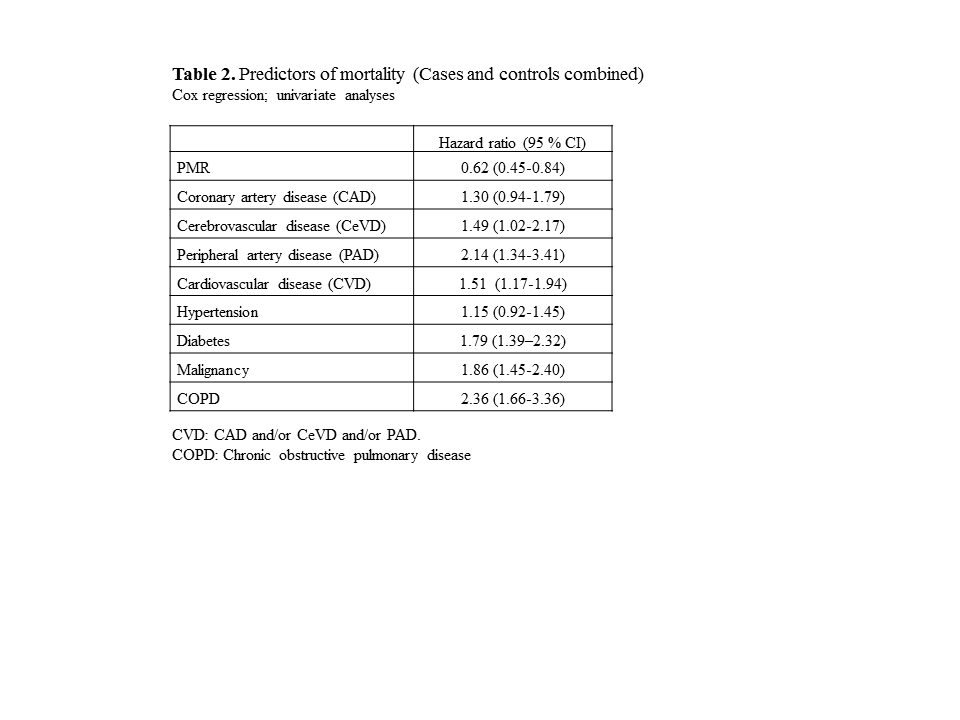Session Information
Session Type: Poster Session A
Session Time: 9:00AM-11:00AM
Background/Purpose: There is limited information on mortality in patients with polymyalgia rheumatica (PMR), and on prevalent comorbidity at the time of diagnosis of PMR. The purpose of this study was to investigate survival in a community-based sample of patients with PMR diagnosed in primary health care (PHC) compared to the general population. Furthermore, we assessed comorbidities diagnosed prior to PMR diagnosis, and their impact on mortality.
Methods: A community-based cohort of consecutive patients with a validated diagnosis of PMR at two PHC centres (1) between 2000 and 2013 was investigated. Validation was based on a review of the electronic records by an experienced rheumatologist, taking into account the disease course and differential diagnoses. Four controls, matched for age, sex and municipality were retrieved from the regional health care database. The index date was defined as the date of PMR diagnosis in cases and the corresponding date in the matched controls. Cases and controls were censored at death, emigration, 10 years of follow-up or the end date of the study (December 31, 2018). Prevalent comorbidity was defined as ≥1 ICD-code indicating a predefined condition prior to the index date. Survival in PMR cases and controls was estimated using the Kaplan-Meier method (log rank test). The impact of PMR and comorbidities was investigated in Cox regression models.
Results: One hundred and thirteen patients with verified PMR (68 % women, mean age at diagnosis 75.3 years) and 452 matched controls were included. There were 40 (35.4%) deaths among the PMR cases, and 252 (55.7%) among the controls. Survival was significantly higher in PMR cases compared to controls (Figure 1). There was not a single death during the first 0.7 years after diagnosis among the patients with PMR (Figure 1). Among the investigated comorbidities, diabetes, malignancy and hypertension were diagnosed in significantly lower proportions prior to the index date in patients with PMR compared to controls (Table 1). Prevalent malignancy, diabetes and cardiovascular disease (CVD) were all associated with increased mortality in pooled analysis of cases and controls (Table 2). In analysis adjusted for malignancy, diabetes and CVD, PMR was associated with reduced mortality (adjusted hazard ratio (HR) 0.66; 95 % CI 0.48-0.90). In a sensitivity analysis, excluding the first 0.7 years of follow-up to avoid short term survival bias after PMR diagnosis, the association between PMR and reduced mortality did not reach statistical significance (adjusted HR 0.75; 95 % CI 0.55-1.04).
Conclusion: Patients with PMR diagnosed in PHC had an improved survival compared to the background population, and were less likely to have been diagnosed with several comorbidities. The reduced mortality in PMR may be partly due to a tendency to regard PMR as a diagnosis of exclusion, and a reluctance to make a diagnosis of PMR in patients with serious comorbidities and a poor prognosis. Alternatively, factors that predispose to PMR may protect from other conditions, in particular diabetes and malignancy.
Reference
(1) Fors et al. Rheumatol Adv Pract 2019; 3: rkz033.
To cite this abstract in AMA style:
Turesson C, Sharma A, Fors C, Nilsson J, Mohammad A, Bergström U. Survival and Prevalent Comorbidities in Polymyalgia Rheumatica [abstract]. Arthritis Rheumatol. 2020; 72 (suppl 10). https://acrabstracts.org/abstract/survival-and-prevalent-comorbidities-in-polymyalgia-rheumatica/. Accessed .« Back to ACR Convergence 2020
ACR Meeting Abstracts - https://acrabstracts.org/abstract/survival-and-prevalent-comorbidities-in-polymyalgia-rheumatica/



